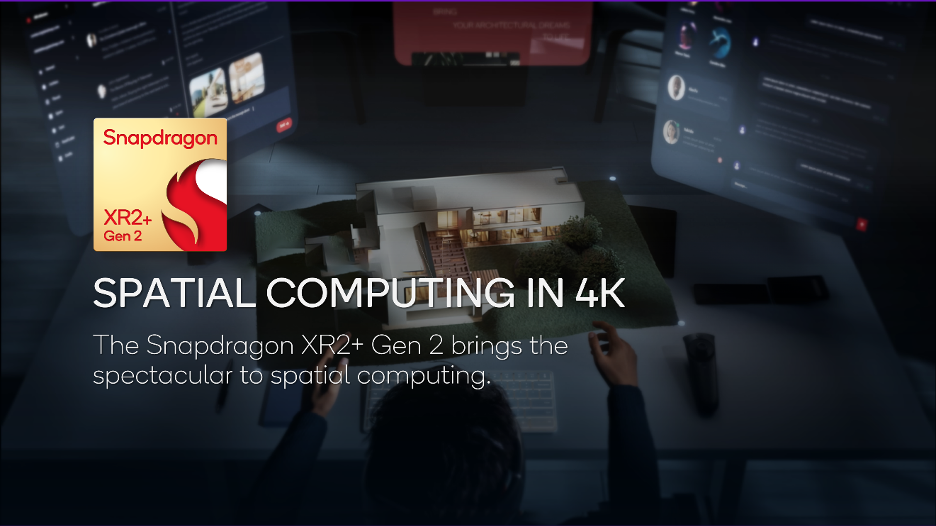
CES 2024 is poised to be the show where the entire XR ecosystem preps its product launches ahead of the imminent launch of the Apple Vision Pro headset. As everyone anticipates the Vision Pro and its high-resolution displays, Qualcomm is poised to enable the whole ecosystem to compete with Apple using its latest XR platforms. It may feel like Qualcomm just announced its XR2 Gen 2 platform, and in fact that happened only in October. Now, however, Qualcomm is introducing yet another XR platform in rapid succession to its XR2 Gen 2 and AR1 Gen 1 products launched last year.
Snapdragon XR2+ Gen 2
Qualcomm is pressing ahead on performance with the XR2+ Gen 2, which is a meaningful step up from the XR2 Gen 2 platform already out in the wild in Meta’s Quest 3 headset. The XR2 Gen 2 was already a considerable performance improvement over the XR2 Gen 1, with 2.5X better GPU performance and 8X better AI performance, along with support for 3K x 3K per-eye displays. The XR2+ Gen 2 takes things further by introducing support for 4.3K x 4.3K per-eye displays. This very much feels like Qualcomm and Meta are painting a target on Apple’s back, because it is the same resolution of the displays announced for the Apple Vision Pro. The Vision Pro has 23 million pixels across both displays, which equates to about 3.4K x 3.4K per eye, surpassing the XR2 Gen 2 but falling short of the XR2+ Gen 2.
There’s an interesting wrinkle here. Suppose you enabled exactly 4.3K x 4.3K per eye. In that case, you would end up with roughly an 8K resolution display, which is incredibly difficult to power with a mobile chipset. That’s why Qualcomm had to increase GPU clocks by 15% and CPU clocks by 20% in the new product. While increased resolutions are generally more GPU-bound than CPU-bound, if your CPU is underpowered, you might end up bottlenecking the GPU’s performance—which Qualcomm has avoided here.
Qualcomm also says that it can support the new higher resolution at 90 FPS. This implies that foveated rendering will become a must for devices using such high-resolution displays, because foveated rendering only renders the area a person’s eyeball is focused on rather than the whole screen. (It renders everything outside of the focal area at a lower resolution.) Apple and Sony are already using foveated rendering in their headsets, and the whole industry will have to move in that direction to maximize comfort, image quality, battery life, and performance. This is a topic I’ve talked about in detail in a 2018 paper about foveated rendering that I wrote in collaboration with eye-tracking leader Tobii.

Qualcomm also increased the camera support to 12+ cameras per device, up from 10 in the XR2 Gen 2, which itself increased from seven in the original XR2 Gen 1. Some of those cameras include user-facing cameras for eye-tracking, which are necessary to enable the foveated rendering capabilities that I expect will be necessary for 4K x 4K per-eye resolution. Qualcomm has long worked with Tobii, a leader in the eye-tracking space for both commercial and consumer applications, and the supplier for the Sony PlayStation VR2 headset’s eye-tracking system. That partnership continues to deepen between the two companies; it has complemented Qualcomm’s work with headset ODM Goertek to create an eye-tracking-enabled reference headset for OEMs to bring products to market more quickly.
Qualcomm says that it already has more than five OEMs in development with the current XR2+ Gen 2, and there’s a chance we could see some of them announced as early as CES. We already know that one of those OEMs is Samsung, which announced its partnership with Qualcomm and Google almost a year ago at Samsung Galaxy Unpacked 2023.
Google and Samsung
Both Samsung and Google are quoted in Qualcomm’s release about the new XR2+ Gen 2 platform for XR headsets, which means that whatever new MR/VR headset Samsung and Google will put out will almost certainly ship with an XR2+ Gen 2. This also gives us a clearer idea about the performance and high resolution that we could expect from Samsung’s XR headset.
Samsung is a very close partner of Qualcomm’s, especially since Samsung went 100% Snapdragon in 2023 for its flagship devices. While that arrangement could change this year, Samsung remains firmly aligned with Qualcomm. It also seems to be strengthening its relationship with Google as all three companies look for a way to challenge Apple’s impending Vision Pro launch. I believe that whatever Samsung, Google, and Qualcomm create should cost a fraction of what Apple’s headset will cost, and that’s already a positive development.
Wrapping up
While the XR2+ Gen 2 is a considerable improvement on the XR2 Gen 2, it is pretty clear that this launch needs to be seen in the context of what is happening more broadly within the industry. The XR2+ Gen 2 will be at the core of what Samsung and Google use to compete with Apple in XR.
In this context, it’s essential to remember that Apple’s Vision Pro is a two-chip solution: the M2 will handle CPU and GPU processing workloads, while the R1 will handle all the cameras, microphones, and other sensors. The R1’s camera latency is 12ms, the same as Qualcomm’s XR2+ Gen 2, which produces passthrough video for mixed reality. Qualcomm’s XR2 series combines these capabilities into a single chip in the form of the XR2+ Gen 2, matching or surpassing many Apple M2 + R1 capabilities.
I believe that Samsung and Google are happy that Qualcomm has a chipset ready as a complete SoC. Even better, this SoC is specialized for XR applications and already proven across multiple generations to have flagship-tier performance levels for an XR device. Things are heating up in the XR space, and we’re only in the first week of January. I expect things will only get more interesting in XR throughout 2024.






















































































